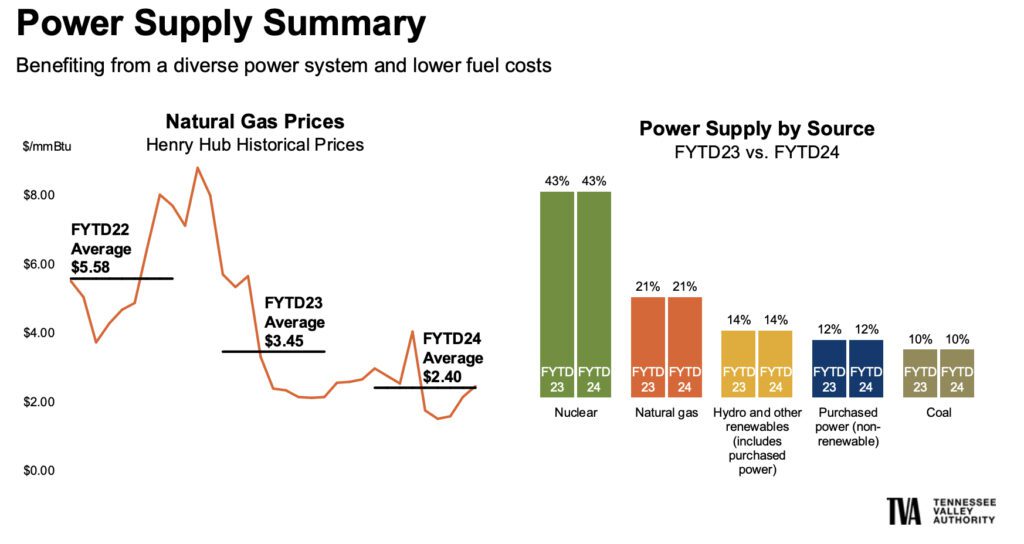TVA Boosts Nuclear Funding with $150M for SMR Development at Clinch River
The Tennessee Valley Authority (TVA’s) board of directors has approved an additional $150 million for the public power utility’s $200 million New Nuclear Program to boost continued design work and development of potential small modular reactors (SMRs) at TVA’s Clinch River site near Oak Ridge, Tennessee.
The combined $350 million funding for the project will support the comprehensive planning, design, and regulatory processes necessary for the deployment of SMRs through fiscal year 2026. A key aim is to ensure that TVA is well-positioned to lead in the adoption of advanced nuclear technology, the utility said on Aug. 22.
“We believe advanced nuclear technologies will play a critical role in our region and nation’s drive toward a clean energy future,” said Jeff Lyash, TVA president and CEO. “Today’s Board decision demonstrates TVA’s commitment to continue leading in this effort. SMRs are an energy innovation technology that America must dominate—for our energy security, which is really our national security.”
A Systemic Roadmap to Explore New Nuclear
The nearly doubled funding cap marks a significant vote of confidence by the board for TVA’s New Nuclear Program, which the company launched, with the board’s approval, in February 2022. “The New Nuclear Program provides a disciplined, systematic roadmap for TVA’s exploration of advanced nuclear technology, both in terms of various reactor designs being proposed and potential locations where such facilities may be needed in the region to support future energy needs—as outlined in TVA’s Strategic Intent,” the company said on Thursday.
In February 2022, Lyash announced the new program would pursue phased activities that would kick off with the design and licensing of a potential GE Hitachi BWRX-300 SMR at Clinch River, a 935-acre site in Roane County for which TVA holds the nation’s only early site permit (ESP) from the Nuclear Regulatory Commission (NRC). Under the New Nuclear Program, TVA is currently preparing an NRC construction permit application for a BWRX-300 at Clinch River that could target deployment in the 2030s, though its final approval will be subject to the required environmental review and the board’s approval, TVA confirmed on Thursday.
However, the program is also evaluating several advanced reactor designs, including light-water and non-light-water cooled reactors, for potential deployment in the 2040s. TVA said more “than a dozen vendors” have provided “detailed information” to support the Programmatic Environmental Impact Statement.
Other key tenets of TVA’s nuclear strategy entail preserving, extending, and optimizing its existing nuclear fleet and researching and exploring large-scale gigawatt-scale nuclear options.

A Template for SMR Deployment
Last year, Lyash told POWER he envisions Clinch River as a pivotal site that could serve as a template for deploying multiple SMRs across TVA’s service territory, starting with a four-unit setup that could be replicated at other locations. “I’ve said very vocally, I [want] nothing to do with building one reactor, unless I can build 20—and 20 is the low estimate—and so, this is what Clinch River is about,” Lyash said as a guest on The POWER Podcast. “There’s an optimum way to build four units. It includes a lot of overlap—supply chain, labor, etc. That’s what we want to develop, but we’re going to ‘unlap’ the first unit so that we can learn all those lessons, identify all those risks, and make units two and three and four look significantly better and different, so that when we build site two, three, and four, we’ve got that,” he said.
TVA is working with several technology partners in its bid to explore new nuclear. These include Ontario Power Generation (OPG) in Canada and Orlen Synthos Green Energy in Poland, both of which are involved in the development of the BWRX-300 small modular reactor (SMR). In March 2023, TVA, OPG, and Synthos kicked off efforts to collaborate on a standard design for the BWRX-300 to speed up the technology’s regulatory acceptance and spur future deployments. Under the collaboration, the companies will also develop a detailed design for key BWRX-300 power plant components, such as reactor pressure vessels and internals. In addition, the three power companies are slated to form a “Design Center Working Group” whose purpose will be “ensuring the standard design is deployable in multiple jurisdictions.”
Alongside a partnership with GE Hitachi dedicated to the planning and licensing of a BWRX-300 at the Clinch River site, TVA is working with Kairos Power, Bruce Power, Constellation, and Southern Co. on Kairos’s efforts to develop its advanced fluoride salt-cooled high-temperature reactor (KP-FHR). Kairos on July 30 announced construction had begun on Hermes, its 35-MWth iterative non-power demonstration molten salt nuclear reactor, at the East Tennessee Technology Park Heritage Center (ETTP) site in Oak Ridge. TVA’s other nuclear partners include Oak Ridge National Laboratory (ORNL) and the University of Tennessee, which contribute critical expertise in advanced nuclear research, technology evaluation, and workforce development.
TVA on Thursday said its efforts are geared toward supporting “a path from first-of-kind technology deployment to cost-effective commercial deployment at scale.” However, the federal corporation underscored that “additional support and collaboration will be needed.”
“Government and policy support is needed to realize the benefits of new nuclear. First-of-a-kind nuclear technology, like any innovative technology, carries financial and technical risks better shared by multiple partners,” it noted. “Federal government support is also essential to the advancement of first-of-a-kind technology deployment due to the risks and additional costs that are inherent to the technology deployment process. In order to reach its long-term net-zero carbon emissions aspirations, TVA will need to consider multiple clean energy technologies, including SMRs, and government support will be critical to timely deployment of SMR technologies in the U.S.”
TVA Is Gearing Up for a Demand Surge
On Thursday, TVA’s board of directors approved a 5.25% base rate increase, which the utility has said is necessary to support a massive generation and infrastructure build-out and keep pace with its surging power demand.
While TVA, the nation’s largest public power supplier, currently serves 10 million customers across seven southeastern states, it says its region’s population is growing three times faster than the national average. In 2023, gross domestic product in its service territory “grew 0.5% faster than the national average,” it reported on Thursday.
“In 1974, peak winter demand was at 18,000 MW,” Lyash told the board on Thursday. “In January of this year, we hit our all time peak demand record of over 34,000 MW—twice the load in this valley over that 50 year period, a doubling in 50 years, and to put that challenge against the future, we expect that same doubling in the next 25 years.”
The base rate increase, which will take effect Oct. 1, 2024, will support TVA’s investments of a combined $16 billion through fiscal year 2027. “The agency is building ~3,500 MW and has made great progress by completing 1,400 MW and securing 800 MW of solar this year,” it said.
“As energy demand grows due to greater reliance on electricity, new residents moving to this region, and new economic investment, we need a diverse fleet that leverages multiple generation sources,” said Lyash. “The answer to keeping our energy secure, affordable, and reliable is a well-rounded portfolio that is increasingly carbon-free and substantially expandable—and TVA’s portfolio is one of the most diverse in the nation.”

TVA’s board notably approved a 4.5% base rate increase for fiscal year 2024. The funding supported the completion of 1.5 GW of new gas-fired generation over the past year. That includes three combustion turbine units, a combined 750 MW, at the Colbert Combustion Turbine site in North Alabama and another 750 MW with three new units at the Paradise Combined Cycle plant near Drakesboro, Kentucky.
More units are slated to come online over the next few years. TVA plans to add 500 MW of peaking aeroderivative combustion turbines at Johnsonville in late 2024, 1,500 MW of combined cycle gas power at Cumberland in late 2026, and 300 MW of solar at Lawrence County and Shawnee by late 2028. In addition, TVA says it has invested $1.5 billion to help offset 30% of anticipated load growth over the next 10 years by investing in energy efficiency and demand response.
On Thursday, Lyash noted that TVA’s diverse generation resources have allowed the utility to manage fuel costs effectively. TVA’s residential rates “are lower than 75% of top 100 U.S. utilities and through the first nine months of this fiscal year power rates were three percent lower than the same period last year despite the rate increase,” the company said.
“We plan, as you saw [in the] budget presentation, to invest nearly $16 billion through fiscal year 2027 to build new generation of all types, enhance reliability of existing assets, and on the underlying infrastructure it takes to leverage,” Lyash said. “Our objective is twofold. It’s ensuring we maintain energy security—that’s affordable and reliable energy—and driving toward a low or zero carbon energy future.”
—Sonal Patel is a POWER senior editor (@sonalcpatel, @POWERmagazine).